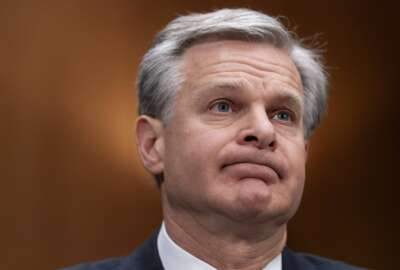Problems surface in government audits of trillions in grants
The GAO found issues with the government audit process at the Federal Audit Clearinghouse, where non-federal grant or aid recipients require single auditing.
If your agency gives grants, you probably know about the Federal Audit Clearinghouse. That’s where so-called single audits go. Single audits of spending by non-federal grant or aid recipients are required by law. The Government Accountability Office (GAO) found the whole clearinghouse process, operated by the General Services Administration, has a few problems. Agencies don’t have the data they need to do single audits. For the details, the Federal Drive with Tom Temin spoke with GAO’s Director of Financial Management and Assurance, Jim Dalkin.
Interview transcript:
Tom Temin If your agency gives grants, you probably know about the Federal Audit Clearinghouse. That’s where so-called single audits go. Single audits of spending by nonfederal grant or aid recipients are required by law. The Government Accountability Office finds the whole clearinghouse process operated by the General Services Administration has a couple of problems. Agencies don’t have the data they need to do single audits. We get the details now from the GAO’s director of financial management and assurance, Jim Dalkin. Jim, good to have you back.
Jim Dalkin Thanks, Tom. Nice to be with you.
Tom Temin Now, these single audits are required by law, correct? Tell us, what is the requirement here? What is a single audit and who’s got to do it?
Jim Dalkin Yes. Well, the Single Audit Act of 1984 required that grants issued by the federal government would be audited. There is a dollar threshold that’s $750,000. So, any grant over $750,000 or more does receive a single audit. And typically what happens is the federal agency distributes the grant. It may go to the state or it may be passed through to a not-for-profit.
Tom Temin Got it. And so, the audit is conducted by the granting agency, or who? I mean, there’s no DGAA like there is a DCAA.
Jim Dalkin Yes. Well, typically what happens is the grants are audited by public accounting firms. And so that’s typically the process that’s used.
Tom Temin And the clearinghouse, then, is the listing, a virtual place where all of the grant information resides such that people are supposed to know what needs to be audited.
Jim Dalkin Yeah. So in a given year, there’s some 40,000 single audits, and they needed clearinghouse to hold all those audits. And there’s a lot of data that you could obtain to see if there are issues, to identify trends and whatnot. Traditionally, that data was held by the Department of Commerce. And then in 2023, they moved it to the GSA.
Tom Temin All right. And so, just to be clear, the clearinghouse contains the results of the audits. But does it also contain the originating agency and grant information also?
Jim Dalkin Yes. So, the database, the requirement is that the grantees submit their annual audit and it’s uploaded into the database. And so you can determine key information about the grantee, key information about their audit, in particular, if there are issues with the audit, those would be flagged enabled. You could identify those through this process.
Tom Temin Right. In other words, because the audits are done by external third parties, the agency needs to kind of check on it to make sure that the third party external auditor didn’t find that they were spending money on cases of Jim Beam Scotch. Well, it’s not just Scotch.
Jim Dalkin Other type of control issues.
Tom Temin Right. All right. It’s Bourbon too, by the way. I’ll have to change — I’ll have to edit that. And what did you find when looking at the clearinghouse, then? What are the issues with it that caused you to audit the auditors?
Jim Dalkin Well, there are a number of challenges with the clearinghouse. Now, of course, it is some 40,000 reports on any given year. But there were issues with the data. There are issues with consistency, between the reports and how that’s reported. There are also some data limitations. So, in the world where we’re moving toward using data or mining data, there are just some inherent limitations in what the system was able to maintain and probably most importantly, there were a number of issues that were identified, and we defined the issues, in terms of levels. And we found issues that were what we consider both severe and persistent, so that means that there were some substantial internal control issues with the reports. And persistence means those issues were over the course of more than one year. So, if it’s severe and persistent, that should wave a red flag. And I don’t know to what extent the clearinghouse was monitored for identifying and resolving those findings.
Tom Temin We’re speaking with Jim Dalkin. He is the director of financial management and assurance issues at the Government Accountability Office. And before we get into some of those specifics, does the clearinghouse operate, I don’t know, like the SEC Edgar system, where, in that case, regulated entities upload their data in certain formats for the clearinghouse? Do these external auditors upload their information according to a certain procedure?
Jim Dalkin Yes, it is similar, in a way, to Edgar, in that data is maintained there and you can access that information.
Tom Temin All right. So, what issues did you find? Were they the result of the uploaders, the auditors, or the result of some governmental function?
Jim Dalkin Well, it was a combination. There were some reports, we believe, that were missing. There were some reports that had edit errors or input errors. There were some reports that were just limited in terms of one’s ability to drill down into some of the issues.
Tom Temin And therefore, it would be difficult for agencies that originated those grants to know whether the spending was proper.
Jim Dalkin Yes. The whole purpose of having these single audits is to provide some sort of assurance that those federal grants are are being used in a way, where they are considering the controls, and so, the database should help. But what we really found were there were the areas in the database that really could be enhanced. And, in part, this report is very timely because it is being moved or it was moved from one agency from the Department of Commerce over to the GSA. So there were some opportunities in the new system to develop some of these fixes that would help with that data.
Tom Temin And by the way, is there any alerting system so that a given granting organization in the federal side would know, hey, your audit is ready?
Jim Dalkin That’s a good question. And I think that is one of the opportunities to to add some extra bells and whistles to the new system.
Tom Temin So then you made some recommendations to GSA to improve the data management and the database system underlying all of this.
Jim Dalkin Ultimately, we made a ten recommendations and four of them were directed to the GSA, and six of them were directed to the Office of Management and Budget.
Tom Temin What would you have the GSA do? Let’s start there.
Jim Dalkin Well, the GSA has some opportunities. They have some opportunities to do some enhanced data checks. They have some opportunities to look at data reliability. They need to step back and look for features, or I call them enhanced features for data mining. There’s also some coordination. You know, some of these grants cross over multiple agencies, and trying to coordinate and the track the dollars can be a challenge. So there’s some opportunities there. And, finally, we said you really need to develop some training, to enhance the quality of the data input.
Tom Temin And what about for the OMB?
Jim Dalkin Well, for OMB, there is a requirement that they conduct a quality review. We noted that the quality review had not been done in a number of years. So, we flagged that as a recommendation to go ahead and move forward with the quality review. We also asked them to develop a process to identify when reports are missing. So, if a grantee didn’t submit, how does OMB know that they didn’t submit? Finally, we looked at the issue again of crossover programs and tracking the dollars when multiple agencies are giving out money. And in looking at the the overall risk. So if there was severe and persistent problems, if you step back, what does that tell OMB in terms of their management and how can they address some of these unresolved problems?
Tom Temin And by the way, we’re not talking about trivial dollars. There’s a chart in your report that talks about the severity and persistence of single audit findings by direct expenditure and 25% in that period, 2017 to 2021, amounting to, well, one and three-quarters of a trillion dollars’ direct expenditures with findings that are either severe or persistent. So there’s spending issues themselves are in there besides data management issues about the reports themselves.
Jim Dalkin Yes, it is substantial spending, I think from 2017 to 2021, which is a period we covered, it was about $7 trillion in federal grants. And of those grants we found, as you mentioned, about one trillion that were severe and persistent. So there were issues with with those grants.
Tom Temin So the better the oversight system, the better the collection of data that’s uniform from audits, the better the government collectively can manage grants, you might say.
Jim Dalkin Yes, the better the data, the better the systems they put in place to monitor that data, would really help in in terms of identifying trends and issues that are occurring within those grant programs.
Tom Temin It sounds like the clearinghouse is a candidate for the high risk list.
Jim Dalkin Well, I can’t speak to the high risk list, but it is certainly large dollars going through on an annual basis. I think in 2023 there was about $1.1 trillion. And, again, it was about 40,000 audits. So, that’s pretty significant.
Tom Temin Gosh, I’m old enough to remember when the government only wasted billions at a time. Jim Dalkin is director of financial management and assurance at the Government Accountability Office. Thanks so much for joining me.
Jim Dalkin Thanks, Tom.
Tom Temin And find this interview, along with a link to his report at federalnewsnetwork.com/federaldrive. Subscribe to the Federal Drive wherever you get your podcasts.
Copyright © 2025 Federal News Network. All rights reserved. This website is not intended for users located within the European Economic Area.
Tom Temin is host of the Federal Drive and has been providing insight on federal technology and management issues for more than 30 years.
Follow @tteminWFED






